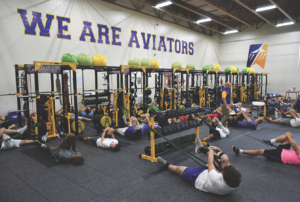
Creating a Safe and Effective High School Strength Program
- 0
Strength training is a crucial component of any high school athlete’s training routine. It not only helps improve their performance on the field, but also reduces the risk of injuries. However, it is essential to create a safe and effective strength program that suits the needs and abilities of high school students. In this article, we will discuss the key components of building a strong and safe high school strength program.
1. Assessment and Planning
Before implementing a strength program, it is vital to assess the individual needs and abilities of the students. This assessment helps identify any pre-existing injuries, muscle imbalances, or movement limitations that need to be addressed. A qualified strength and conditioning coach should conduct these assessments to develop an individualized plan for each student.
Importance of Proper Technique
One of the most critical aspects of a safe and effective strength training program is ensuring proper technique. Emphasize the importance of maintaining proper form during all exercises. This not only maximizes the benefits of the training but also reduces the risk of injuries. Students should be taught the correct posture, alignment, and range of motion for each exercise.
2. Gradual Progression
When designing a strength program for high school students, it is essential to implement a gradual progression model. Starting with lighter weights and gradually increasing the load ensures that the students’ bodies adjust and adapt to the training stimulus. It also prevents overtraining and minimizes the risk of injury. Progression should be monitored closely, and adjustments should be made accordingly.
Variety and Balance
Avoid creating a monotonous training plan by incorporating a variety of exercises that target different muscle groups. This helps prevent muscle imbalances and keeps the workout interesting for the students. Balancing upper body and lower body workouts, as well as incorporating core strengthening exercises, helps develop a well-rounded athlete.
3. Warm-Up and Cool-Down
Proper warm-up and cool-down routines are crucial in preventing injuries and enhancing performance. The warm-up should consist of dynamic stretches and mobility exercises that prepare the muscles and joints for the workout. The cool-down should include static stretches to prevent muscle tightness and promote recovery. Coaches should guide students through these routines and emphasize their importance.
The Role of Nutrition and Hydration
A high school strength program cannot be effective without proper nutrition and hydration. Coaches should educate students about the importance of fueling their bodies with the right nutrients before and after workouts. Encourage them to consume a well-balanced diet that includes lean proteins, complex carbohydrates, and healthy fats. Additionally, staying hydrated throughout the day and during workouts is crucial for optimal performance and recovery.
4. Supervision and Safety
High school students must be supervised during strength training sessions to ensure their safety. A qualified coach should be present to guide the students, correct their form, and prevent any potential injuries. Additionally, it is important to have proper safety measures in place, such as using appropriate equipment, ensuring a clean training environment, and enforcing proper gym etiquette.
Consistency and Recovery
A successful strength program relies on consistency and recovery. Students should be encouraged to follow the program consistently and attend regular training sessions. However, it is equally important to incorporate rest days and recovery techniques, such as foam rolling and stretching. This allows the body to repair and rebuild, reducing the risk of overuse injuries and promoting overall well-being.
5. Monitoring and Adjustments
A high school strength program should be regularly monitored to track progress and make necessary adjustments. Regular assessments help identify areas of improvement and allow for modifications to be made to the program. This ensures that the program remains effective and meets the evolving needs of the students.
Conclusion
Creating a safe and effective high school strength program requires careful planning and attention to detail. By considering the individual needs and abilities of the students, implementing proper technique, and emphasizing gradual progression, coaches can help athletes improve their performance while reducing the risk of injuries. Incorporating warm-up and cool-down routines, focusing on nutrition and hydration, and providing adequate supervision are also crucial aspects of an effective program. By following these guidelines, high school athletes can develop strength, resilience, and overall fitness.

